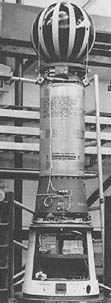San Marco 1
 | |
| Mission type | Ionospheric Earth science Astrophysics[1] |
|---|---|
| Operator | CNR |
| COSPAR ID | 1964-084A |
| SATCATno. | 00957 |
| Mission duration | ~272 days |
| Spacecraft properties | |
| Launch mass | 115.2 kilograms (254 lb)[1] |
| Start of mission | |
| Launch date | 15 December 1964, 20:24:00UTC[1] |
| Rocket | Scout X-4[2] |
| Launch site | WallopsLA-3A |
| End of mission | |
| Decay date | 13 September 1965[1] |
| Orbital parameters | |
| Reference system | Geocentric |
| Regime | Low Earth |
| Eccentricity | 0.0469[1] |
| Perigee altitude | 198.0 kilometres (123.0 mi)[1] |
| Apogee altitude | 846.0 kilometres (525.7 mi)[1] |
| Inclination | 37.80 degrees[1] |
| Period | 94.9 minutes[1] |
| Epoch | 15 December 1964 20:24:00 UTC |

San Marco 1,also known asSan Marco A,was the firstItaliansatellite.Built in-house by the Italian Space Research Commission (Italian:Commissione per le Ricerche Spaziali,CRS) on behalf of theNational Research Council,it was the first of five as part of the Italian-USSan Marco programme.
The name of the spacecraft series comes from the San Marco platform, aJackup bargeused as an offshore launch pad for the main phase of the project. San Marco (English:Saint Mark) is thepatron saintofVenice,often depicted as aiding Venetian sailors.[3]
Development
[edit]In 1961 the Italian government, led byAmintore Fanfani,approved a plan for the development of an indigenous satellite research programme that had earlier been proposed by the CRS. At the time only theSoviet Unionand theUnited Stateshad launchedspacecraft into orbitand Italy lacked a suitable launcher and crews trained in firing orbital rockets. As a result, a cooperative plan was developed with the American space agencyNASAwho would provide the rockets and the launch crew training for Italians to operate them.[3]
The spacecraft was built by members of the CRS, a group of distinguished Italian scientists and engineers includingEdoardo Amaldi,co-founder of major European scientific organisations includingCERNandESRO.
The mission was principally a test-flight of a real satellite to gain experience before launches from Italy's ownSan Marco platformbegan, the last of 3 phases of the project.[4]
Mission
[edit]The primary mission of the San Marco series was to conductionospheric(upper-atmosphere) research. As a test satellite San Marco 1 contained relatively few experiments;
- Atmosphere,anIonprobe.
- Electron-content Beacon,a radiotransmitterto study ionospheric effects on long-range radio communication.
Launch
[edit]San Marco 1 was launched by an Italian crew using an AmericanScoutrocket fromWallops Flight Facility,Virginia, US. Launched on 15 December 1964 at 20:24:00 UTC the satellite destructively re-entered the atmosphere on 13 September 1965.
See also
[edit]- San Marco programme
- Italian National Research Council
- Scout rocket
- Wallops Flight Facility
- Broglio Space Centre- formerlySan Marco Equatorial Range
- Timeline of artificial satellites and space probes
References
[edit]- ^abcdefghi"San Marco 1".NASA – National Space Science Data Centre.Retrieved2010-08-31.
- ^Krebs, Gunter."San Marco 1, 2 (A, B)".Gunter's Space Page.Retrieved2010-08-27.
- ^ab"II. SATELLITES".NASA History Office.Retrieved2010-08-24.
- ^"Chapter 18 - Cooperation With Western Countries".NASA History Office.Retrieved2010-08-24.
